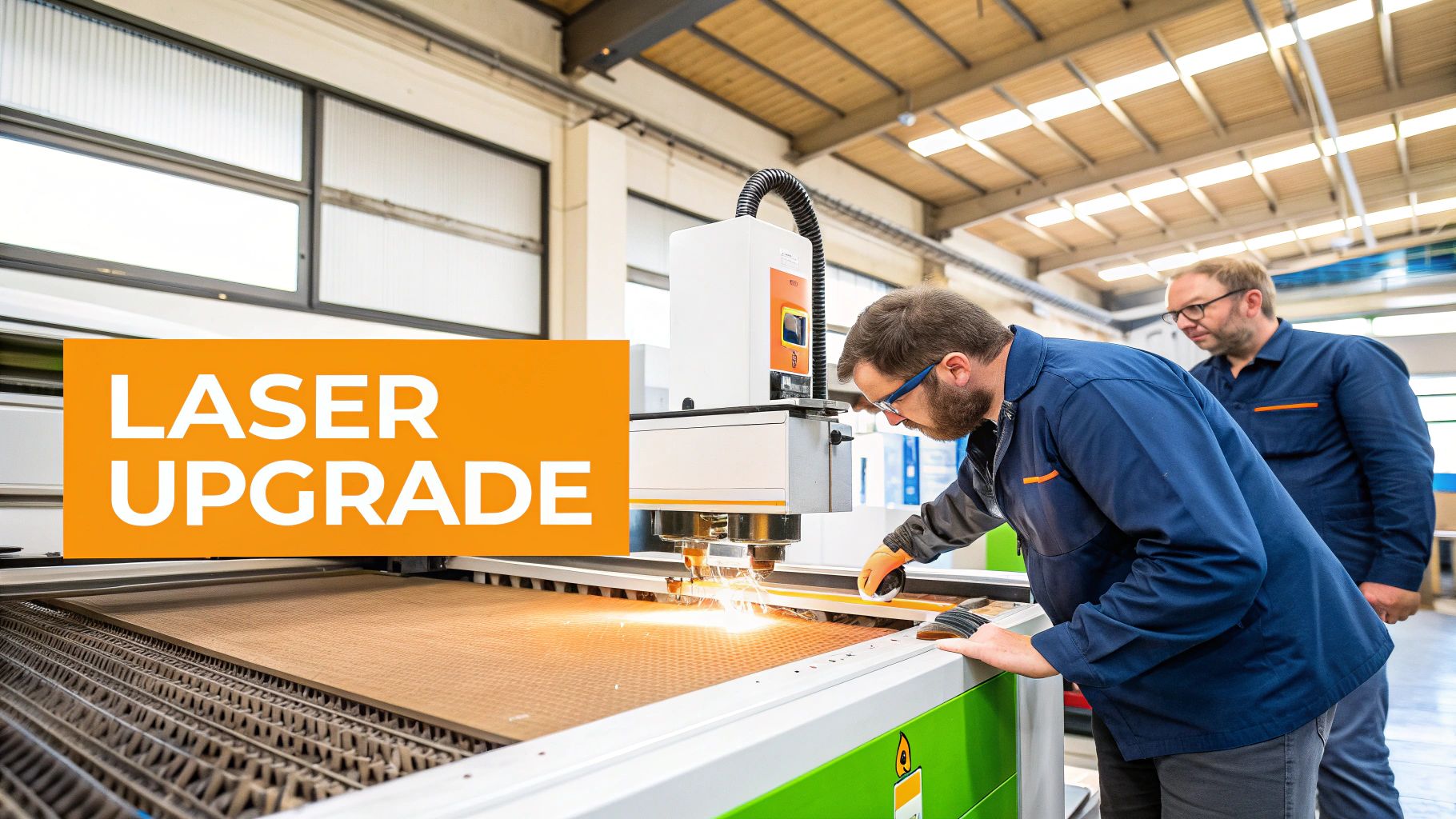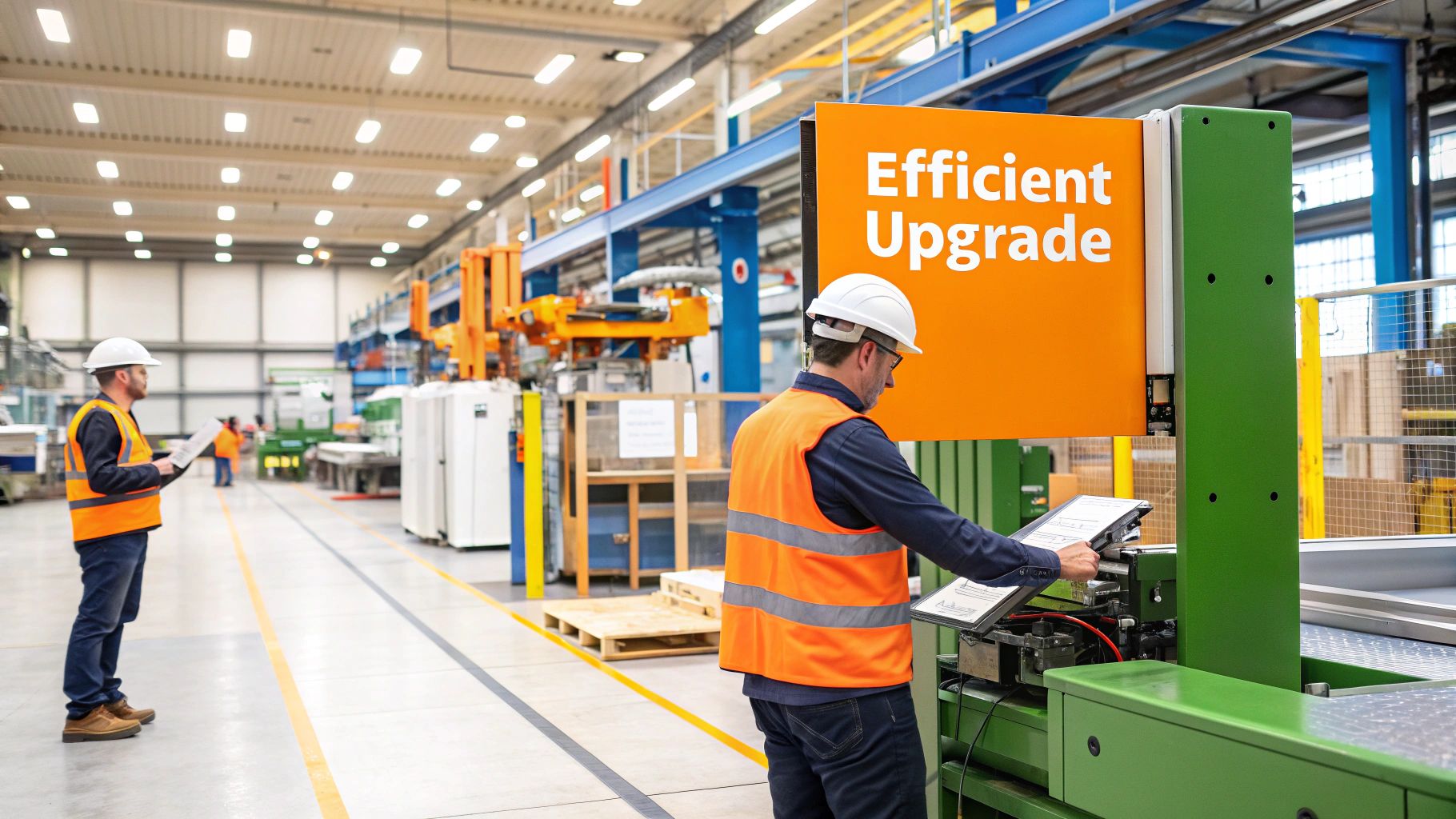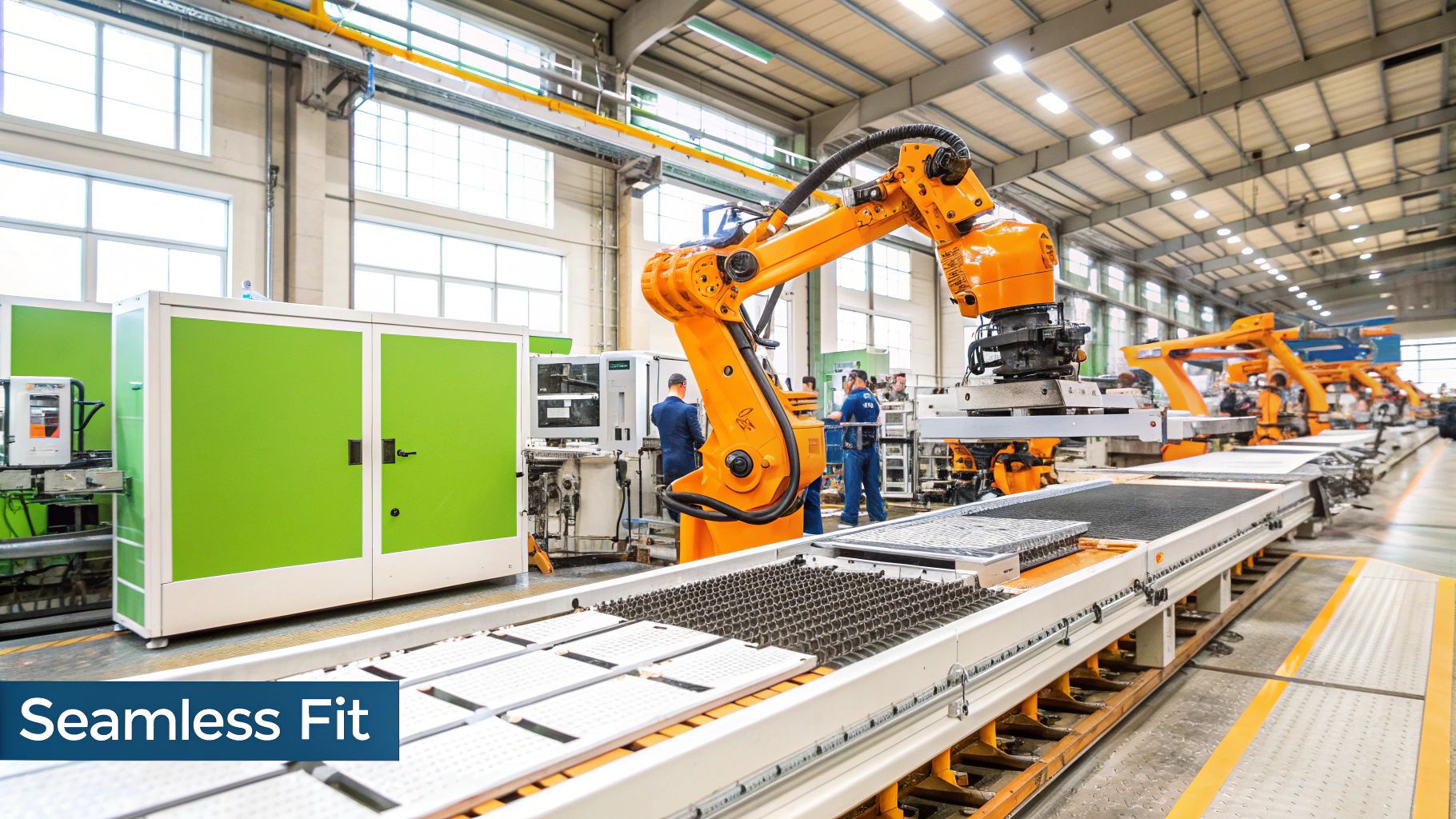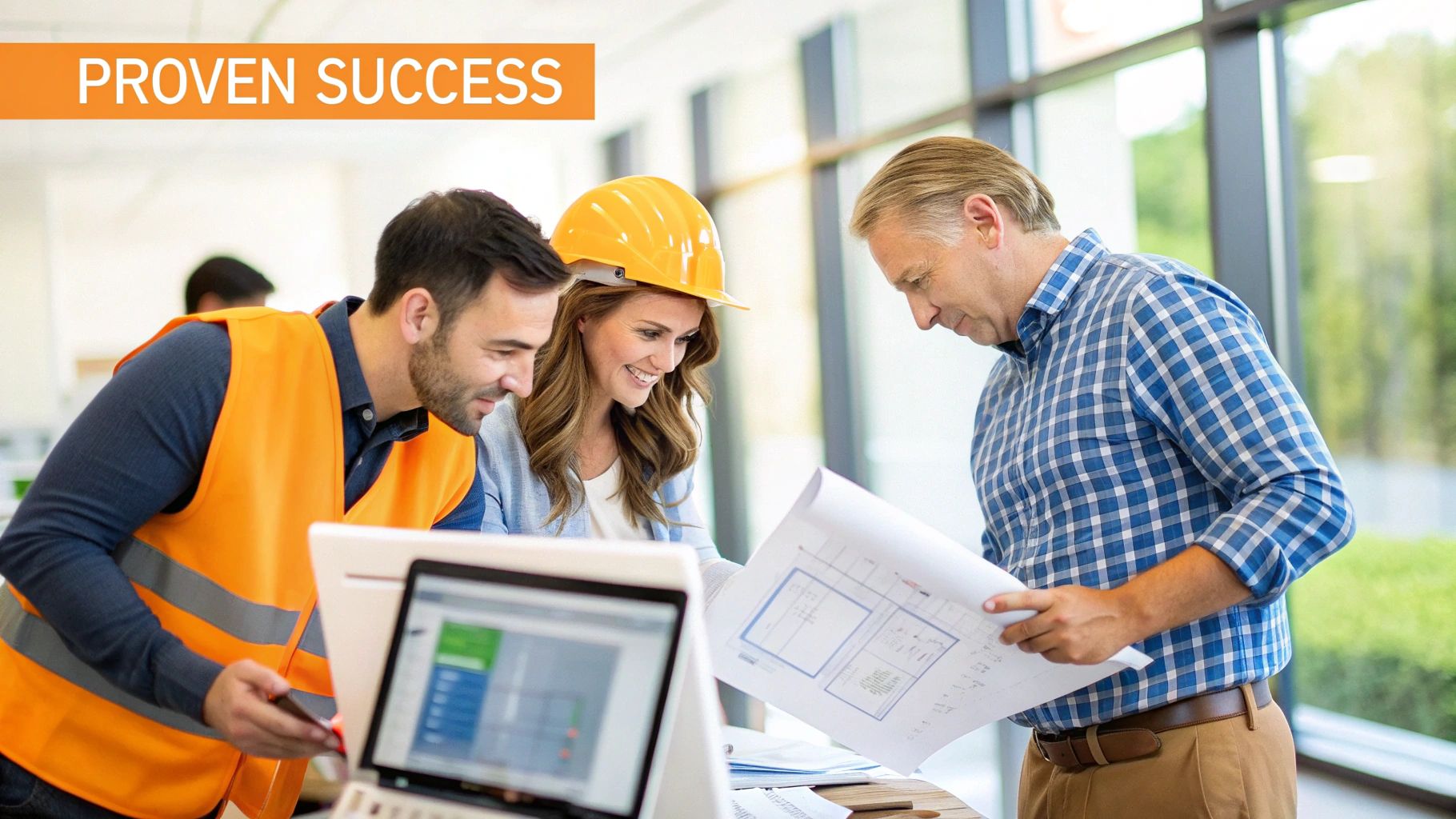Неиспользованный потенциал модернизации лазерных станков

Услуги по модернизации лазерных станков представляют собой убедительную альтернативу покупке совершенно нового оборудования. Модернизация вдохнет новую жизнь в ваше существующее оборудование, улучшая его возможности и продлевая срок службы. В отличие от простого ремонта или планового обслуживания, модернизация сосредоточена на обновлении основных компонентов. Это превращает старое оборудование в современный, высокоэффективный актив. Представьте это как ремонт дома – вместо полной перестройки вы стратегически обновляете ключевые области для улучшения функциональности и стоимости.
Ключевые компоненты для повышения производительности
Несколько ключевых компонентов обеспечивают наибольший прирост производительности при модернизации лазерного резака. Одной из ключевых областей является система управления. Устаревшие системы управления могут создавать узкие места в работе старых станков. Их замена на современные, удобные интерфейсы повышает точность, скорость и возможности автоматизации.
Еще одно важное обновление касается аппаратного обеспечения для точного движения, такого как линейные направляющие и шариковинтовые передачи. Эти улучшения значительно влияют на точность резки и повторяемость. Наконец, замена или восстановление современной оптики, включая линзы и зеркала, улучшает качество луча и общую эффективность резки.
Рост популярности модернизаций в производстве
Производители, ориентированные на будущее, все чаще выбирают стратегические модернизации, чтобы соответствовать меняющимся требованиям отрасли. Чтобы оставаться конкурентоспособными, необходимо внедрять передовые технологии. Глобальный рынок лазерных станков для резки, в настоящее время оцениваемый примерно в 5,94 миллиарда долларов, прогнозируется к росту с среднегодовым темпом 7,6% до 2032 года.
Этот рост обусловлен внедрением технологий Индустрии 4.0, включая Интернет вещей (IoT) и анализ данных. Более подробную статистику можно найти по адресу: https://scoop.market.us/laser-cutting-machine-statistics/. Это ясно демонстрирует растущую необходимость модернизации существующих станков для сохранения конкурентоспособности. Эта тенденция указывает на переход к максимальному использованию имеющихся активов, а не к автоматическому выбору дорогостоящей замены. Хорошо выполненная модернизация может реально продлить срок службы станка на 5-10 лет, а иногда и дольше, в зависимости от объема обновления и первоначального состояния станка.
Оценка вашей машины на пригодность для модернизации
Определение того, подходит ли ваше оборудование для услуги модернизации лазерного резака, требует тщательного рассмотрения. Следует оценить такие факторы, как возраст машины, текущее состояние и желаемые улучшения производительности.
Если основная конструкция надежна, а желаемые обновления технологически осуществимы, модернизация, вероятно, будет экономически эффективным решением. Однако, если машина имеет значительный износ или требует обширного структурного ремонта, полная замена может быть более практичным вариантом. Эта оценка помогает определить наилучший финансовый и операционный путь, обеспечивая максимальную отдачу от инвестиций и достижение производственных целей.
Почему умные производители выбирают модернизацию вместо замены

Модернизация вашего лазерного станка для резки предлагает значительные преимущества по сравнению с покупкой нового оборудования. Этот подход не только обеспечивает существенную экономию средств, но и минимизирует перерывы в производстве. Для производителей, стремящихся оптимизировать свои операции и повысить прибыль, модернизация представляет собой убедительное и финансово обоснованное решение. Она позволяет компаниям достичь производительности, сопоставимой с новыми моделями, за часть стоимости, часто около третьей части цены.
Экономия средств и повышение производительности
Одним из основных факторов растущей популярности услуг по модернизации лазерных резательных станков является значительный потенциал снижения затрат. Производители часто сообщают о сбережениях в диапазоне 40-60% по сравнению с значительными инвестициями, необходимыми для нового оборудования. Это может освободить ценный капитал для реинвестирования в другие критически важные области бизнеса, такие как исследования и разработки или обучение персонала. Кроме того, модернизированные машины часто могут соответствовать, а иногда даже превосходить производительность новых моделей. Это приводит к улучшению пропускной способности, повышению качества и увеличению общей эффективности.
Устойчивость и долгосрочная ценность
Помимо непосредственных финансовых преимуществ, модернизация идеально соответствует растущему вниманию к устойчивому развитию в производственном секторе. Продлевая срок службы существующего оборудования, компании активно сокращают отходы и сохраняют ценные ресурсы. Этот экологически ответственный подход находит отклик как у бизнеса, так и у потребителей, способствуя положительному имиджу бренда и демонстрируя приверженность ответственным практикам. Более того, стратегические модернизации могут привести к значительному снижению требований к техническому обслуживанию. Обновление до современных компонентов и передовых технологий минимизирует время простоя и оптимизирует операционную эффективность, что приводит к долгосрочной экономии средств и повышению производительности. Узнайте больше о оптимизации ваших операций лазерной резки: Как овладеть...
Чтобы проиллюстрировать финансовые преимущества, давайте рассмотрим сравнение затрат:
Сравнение затрат: модернизация против покупки нового оборудования Подробный разбор затрат, связанных с модернизацией по сравнению с покупкой нового оборудования, включая первоначальные инвестиции, затраты на установку, требования к обучению и долгосрочную окупаемость
| Фактор стоимости | Решение по модернизации | Покупка нового оборудования | Потенциальная экономия |
|---|---|---|---|
| Первоначальные инвестиции | $50,000 | $150,000 | $100,000 |
| Стоимость установки | $5,000 | $15,000 | $10,000 |
| Обучение | $2,000 | $5,000 | $3,000 |
| Время простоя | Минимальный | Значительный | Варьируется |
| Долгосрочная окупаемость инвестиций | Выше | Ниже | Варьируется |
Как вы можете видеть, модернизация предлагает значительную экономию по различным статьям расходов. Это приводит к более высокой долгосрочной рентабельности инвестиций по сравнению с покупкой новой машины.
Улучшение точности и производительности
Услуги по модернизации лазерных станков позволяют производителям достигать беспрецедентных уровней точности. Обновляя системы управления движением до передовых и улучшая оптику, компании могут добиться более строгих допусков и выполнять более сложные резы. Эта повышенная точность особенно важна в требовательных отраслях, таких как автомобилестроение и аэрокосмическая промышленность, где предъявляются высокие стандарты. Рынок лазерных станков в США, который в настоящее время оценивается в $1,32 миллиарда (2023), прогнозируется к достижению $1,95 миллиарда к 2030 году с ростом по среднегодовому темпу 5,9% с 2024 по 2030 год. Этот впечатляющий рост обусловлен такими отраслями, как автомобилестроение и аэрокосмическая промышленность, где точность и эффективность являются ключевыми факторами. Модернизация играет важную роль в этих секторах, позволяя производителям беспрепятственно интегрировать передовые технологии, такие как автоматизация, IoT и ИИ, для повышения производительности и снижения ручного вмешательства. Для более подробной статистики рынка, пожалуйста, обратитесь к этому ресурсу: Grand View Research.
Максимизация бизнес-инвестиций через модернизацию
Выбор модернизации позволяет производителям стратегически распределять капитал на другие важные бизнес-инвестиции. Вместо того чтобы выделять значительные ресурсы на новое оборудование, компании могут перенаправить эти средства на исследования и разработки, комплексные программы обучения персонала или стратегические инициативы по расширению. Такой разумный подход к распределению ресурсов способствует сбалансированному росту и укрепляет долгосрочную конкурентоспособность. Модернизация обеспечивает бизнесу гибкость и адаптивность для приспособления к меняющейся рыночной динамике и поддержания конкурентного преимущества. Эта адаптивность необходима для успешного преодоления сложностей быстро меняющегося производственного ландшафта современности.
Передовые технологии, преобразующие устаревшее оборудование

Модернизация вашей существующей лазерной резательной машины с помощью ретрофита может значительно повысить её возможности. Ретрофит включает интеграцию технологий Индустрии 4.0 для обновления производительности и повышения операционной эффективности. Эти усовершенствования предлагают множество преимуществ, включая повышенную точность, сокращение времени простоя, улучшенное качество реза и более удобный интерфейс для операторов. В конечном итоге такой подход продлевает срок службы вашего оборудования и готовит его к будущему производства.
Влияние технологий Индустрии 4.0
Возможности Industry 4.0, такие как сети датчиков IoT, играют решающую роль в услугах по модернизации лазерных резательных станков. Эти датчики непрерывно контролируют важные параметры производительности, такие как температура, давление и вибрация. Этот постоянный поток данных предоставляет ценные сведения о состоянии и рабочем статусе станка. Эти данные позволяют проводить профилактическое обслуживание и предотвращать неожиданные поломки. Также могут быть интегрированы сложные системы управления, обеспечивающие большую точность и выполнение более сложных схем резки. Это расширяет универсальность станка и его потенциальные области применения.
Например, алгоритмы машинного обучения теперь позволяют осуществлять прогнозное обслуживание, что революционизирует способы минимизации дорогостоящих простоев. Эти алгоритмы анализируют данные машин для выявления закономерностей и прогнозирования потенциальных неисправностей до их возникновения. Такой проактивный подход минимизирует перебои в производственных графиках и значительно снижает затраты на ремонт. Улучшения качества луча дополнительно повышают производительность машины, обеспечивая превосходное качество реза. Это приводит к более чистым краям, меньшему количеству отходов материала и продукции более высокого качества.
Лазерные станки традиционно сталкиваются с проблемами обслуживания и эксплуатационных расходов, особенно в условиях высокой интенсивности. Станки, такие как Trumpf Trumpf 2D лазерные резаки, работающие с шестью киловаттами лазерной мощности, могут испытывать значительный износ, особенно при работе в три смены. Это привело к тому, что компании, такие как Codestryke GmbH, разработали решения для модернизации с использованием технологий IoT для мониторинга и прогнозирования потребностей в обслуживании, что снижает время простоя и повышает общую эффективность оборудования (OEE). Узнайте больше: Обслуживание на основе состояния как модернизация.
Современные пользовательские интерфейсы и проблемы совместимости
Современные, удобные для пользователя интерфейсы являются еще одним ключевым преимуществом модернизации лазерных резательных станков. Эти интерфейсы упрощают сложные операции и предоставляют операторам более интуитивное управление. Это приводит к повышению производительности, снижению количества ошибок операторов и улучшению общего пользовательского опыта. Однако интеграция новых технологий с устаревшими архитектурами станков действительно представляет проблемы совместимости. Специалисты по модернизации тщательно оценивают возможности существующего станка и разрабатывают индивидуальные решения, которые бесшовно интегрируются с более старой технологией. Такое тщательное планирование обеспечивает оптимальную производительность и минимизирует потенциальные конфликты между новыми и существующими компонентами.
Новые инновации в области модернизации
Область модернизации лазерных станков для резки постоянно развивается. Появляются новые технологии, расширяющие возможности для улучшений. Эти инновации обещают еще большую точность, эффективность и возможности автоматизации. Например, достижения в области адаптивной оптики позволяют в реальном времени корректировать лазерный луч, компенсируя изменения толщины материала или дефекты. Такое динамическое управление повышает точность резки и улучшает однородность готовой продукции. Будущее модернизации лазерных станков для резки светлое, с постоянными достижениями, формирующими будущее производства.
Внутри пути Retrofit: от оценки до внедрения

Сервис модернизации лазерного станка — это многоэтапный процесс, который обновляет ваше существующее оборудование. Он начинается с тщательной оценки текущих возможностей вашего станка и его потенциала для улучшения. Эта оценка выявляет ключевые области, где обновления принесут наибольший эффект, что приводит к созданию индивидуального плана модернизации, соответствующего вашим производственным потребностям. Для получения дополнительной информации ознакомьтесь с Laser Cutting Insights and Resources. Этот важный первый шаг закладывает основу для успешного и эффективного проекта модернизации.
Первоначальная оценка машины и индивидуальное планирование
Первым шагом в любом сервисе модернизации лазерного станка является полная оценка текущего оборудования. Это включает детальный осмотр критически важных компонентов, включая систему управления, механическое оборудование и оптику. Это обследование выявляет области для улучшения и определяет, какие обновления возможны. Например, возраст и состояние системы управления определят, будет ли достаточно простого обновления программного обеспечения или потребуется полная замена системы.
На основе этой оценки создается индивидуальный план модернизации. В этом плане подробно описаны конкретные улучшения, прогнозируемые улучшения производительности и практический график проекта. Опытные команды по модернизации сотрудничают с вами, чтобы полностью понять ваши производственные потребности и гарантировать, что предлагаемые улучшения соответствуют вашим бизнес-целям. Эта совместная стратегия обеспечивает, что решение по модернизации напрямую решает ваши конкретные производственные задачи. Такой целенаправленный подход максимизирует вашу отдачу от инвестиций и гарантирует бесшовную интеграцию модернизированной машины в ваш существующий рабочий процесс.
Минимизация сбоев и реалистичные сроки
Хорошо спланированная модернизация лазерного станка минимизирует перебои в вашем производстве. Опытные команды по модернизации ценят важность эффективного управления проектом. Типичные сроки варьируются от одной до трёх недель, в зависимости от сложности обновлений. Тщательная подготовка и точная координация минимизируют время простоя, позволяя вам быстро воспользоваться улучшениями.
Механические обновления, системы управления и интеграция программного обеспечения
Этап внедрения услуги по модернизации лазерного станка обычно включает несколько ключевых процедур.
- Механические улучшения: Часто старые компоненты заменяются современными, высокопроизводительными аналогами, такими как прецизионные линейные направляющие и высокоскоростные шариковинтовые передачи.
- Замена системы управления: Новая система управления обеспечивает расширенные функции, улучшенную автоматизацию и удобный интерфейс.
- Интеграция программного обеспечения: Это обеспечивает беспрепятственное взаимодействие между всеми компонентами и интеграцию с вашим существующим производственным процессом.
- Комплексное тестирование: Тщательное тестирование подтверждает работоспособность обновленной системы и удостоверяется, что она соответствует вашим производственным требованиям.
Обучение операторов, переход к производству и поддержка после внедрения
Успешное обновление лазерного станка включает не только технические улучшения. Важно провести комплексное обучение операторов. Это гарантирует, что ваша команда сможет эффективно использовать новые функции и возможности модернизированного станка. Эффективное управление переходом в производстве помогает плавно интегрировать станок в рабочий процесс, минимизируя перебои и оптимизируя производительность. Постоянная поддержка после внедрения обеспечивает доступ к технической помощи и услугам по обслуживанию. Такой комплексный подход гарантирует долгосрочный успех и помогает достичь максимальной производительности с самого начала.
Поиск идеального партнёра по модернизации: за пределами коммерческого предложения
Выбор правильного поставщика для модернизации вашего лазерного станка — это критически важное решение. Оно влияет не только на непосредственную эффективность обновления, но и на ваше долгосрочное удовлетворение. Не ограничивайтесь только первоначальной презентацией продаж; изучите глубже, чтобы понять истинные возможности поставщика и убедиться, что они соответствуют вашим конкретным потребностям.
Ключевые вопросы для выявления экспертизы
Правильные вопросы могут выявить истинную экспертизу поставщика в отношении вашего конкретного типа лазерного резака. Например, спросите об их опыте работы с похожими моделями, включая конкретные проблемы, с которыми они столкнулись, и способы их решения. Узнайте об их подходе к поддержанию актуальности знаний как по устаревшим системам, так и по новейшим достижениям в области лазерной резки. Знающий поставщик охотно поделится своим опытом и продемонстрирует глубокое понимание вашего оборудования.
Оценка прошлых проектов и качества компонентов
Обзор портфолио поставщика с прошлыми проектами модернизации лазерных резательных станков является важным. Сосредоточьтесь на проектах, схожих по объему и сложности с вашим. Это дает конкретные доказательства их возможностей и предоставляет представление о качестве их работы. Также спросите о качестве используемых ими компонентов. Выбор высококачественных деталей свидетельствует о стремлении к долгосрочной надежности и производительности.
Использование некачественных компонентов может привести к преждевременным отказам и увеличению долгосрочных затрат на обслуживание. Тщательная проверка в этой области может предотвратить будущие проблемы.
Документация, поддержка и местная доступность
Тщательная документация является признаком надежного поставщика услуг по модернизации лазерных резательных станков. Подробная документация упрощает процесс перехода и облегчает будущие задачи по техническому обслуживанию. Также важна надежная система поддержки после модернизации. Она включает техническую помощь, ресурсы для устранения неполадок и легко доступные запасные части.
Наличие местной поддержки может значительно повлиять на ваше долгосрочное удовлетворение. Местные техники могут быстро реагировать на любые проблемы, минимизируя время простоя и максимизируя время работы вашей машины.
Условия гарантии и текущего обслуживания
Тщательно изучите гарантию, предлагаемую поставщиком ретрофита. Всеобъемлющая гарантия демонстрирует их уверенность в своей работе и защищает ваши инвестиции. Поставщики, предлагающие партнерство по текущему обслуживанию, обеспечивают значительную дополнительную ценность. Такой проактивный подход к обслуживанию может предотвратить неожиданные поломки и продлить срок службы вашей модернизированной машины.
Красные флаги и стратегии проверки
Остерегайтесь поставщиков, которые делают преувеличенные обещания или уклоняются от конкретных вопросов о своем опыте. Это потенциальные предупреждающие знаки. Проверьте их утверждения, проверив рекомендации и связавшись с предыдущими клиентами. Такая тщательная проверка может защитить вас от дорогостоящих ошибок и гарантировать сотрудничество с надежным и компетентным поставщиком.
Следующая таблица предоставляет структурированный подход к оценке потенциальных поставщиков услуг по модернизации:
Критерии оценки поставщика услуг Retrofit
Основные факторы, которые следует учитывать при выборе поставщика услуг по модернизации лазерного станка, с рекомендациями для принятия обоснованного решения
| Критерии оценки | Почему это важно | Вопросы, которые следует задать | Красные флаги |
|---|---|---|---|
| Опыт | Обеспечивает понимание вашей машины и её тонкостей | "Какой у вас опыт работы с этой конкретной моделью? Можете ли вы привести примеры похожих проектов?" | Неясные ответы, неспособность привести конкретные примеры или отсутствие демонстрируемой экспертизы с аналогичными машинами. |
| Качество компонентов | Непосредственно влияет на долгосрочную надежность и производительность вашей модернизированной машины. | "Какие бренды компонентов вы используете? Можете ли вы предоставить спецификации для этих компонентов?" | Нежелание раскрывать информацию о компонентах, использование универсальных или неизвестных брендов, либо отсутствие прозрачности в отношении источников компонентов. |
| Поддерживать | Необходимо для минимизации времени простоя и быстрого решения любых проблем, которые могут возникнуть после модернизации. | «Какую поддержку вы предлагаете после модернизации? Каковы ваши сроки реагирования на техническую помощь? Есть ли у вас в наличии запасные части?» | Отсутствие чётких процедур поддержки, длительное время отклика или трудности с получением запасных частей. |
| Локальная доступность | Обеспечивает быстрое время отклика для поддержки на месте и минимизирует возможные простои. | "У вас есть местные технические специалисты поддержки? Могут ли они при необходимости предоставить помощь на месте?" | Зависимость только от удалённой поддержки, отсутствие местного присутствия или возможные задержки с получением помощи на месте. |
| Гарантия | Защищает ваши инвестиции и предоставляет возможность обращения в случае дефектов или неисправностей. | "Что покрывает ваша гарантия? Каков срок гарантии? Каков процесс подачи гарантийного требования?" | Короткие сроки гарантии, ограниченное покрытие или сложные и трудные процессы подачи гарантийных претензий. |
Используя эти критерии, вы сможете более эффективно оценить потенциальных поставщиков и выбрать наиболее подходящего для ваших нужд. Выбор правильного поставщика услуг по модернизации лазерного станка — это значительное вложение. Тщательное рассмотрение этих факторов обеспечивает успешную модернизацию и максимизирует вашу отдачу от инвестиций.
Максимизация ROI: превращение инвестиций в модернизацию в измеримые результаты
Сервис модернизации лазерного станка предлагает не только первоначальную экономию средств. Это реальная возможность для постоянной финансовой отдачи. Поняв, как рассчитать ваш полный возврат инвестиций (ROI), вы сможете превратить инвестиции в модернизацию в измеримые долгосрочные выгоды. Это включает анализ увеличения производительности, сокращения отходов материалов, экономии энергии и общего улучшения качества. Возможно, вам будет интересно: Как овладеть...
Установление базовых показателей производительности до модернизации
Перед началом модернизации важно установить чёткую базовую линию текущей производительности вашей машины. Эта предварительная оценка перед модернизацией имеет решающее значение для точного измерения после внедрения. Отслеживайте ключевые показатели, такие как объём производства, отходы материалов, потребление энергии и время простоя. Эти данные служат основой для количественной оценки влияния вашей модернизации и демонстрации её реальной финансовой выгоды.
Расчет полной картины ROI
Расчет полного ROI услуги по модернизации лазерного станка включает оценку нескольких ключевых аспектов. Повышение производительности, часто являющееся прямым результатом обновления компонентов и программного обеспечения, приводит к увеличению выпуска при тех же или меньших ресурсах. Сокращение отходов материалов, достигаемое за счет улучшенной точности и эффективности резки, снижает затраты на материалы и минимизирует брак. Экономия энергопотребления, благодаря более энергоэффективным компонентам, уменьшает эксплуатационные расходы. Наконец, улучшение качества снижает количество ошибок, переделок и возвратов от клиентов.
Типичные сроки окупаемости и примеры из практики
Типичные сроки окупаемости модернизации лазерных резательных станков варьируются в зависимости от объема обновления. Более простые модернизации могут иметь срок окупаемости 6-12 месяцев, в то время как более масштабные капитальные ремонты могут занимать от 12-24 месяцев. Реальные примеры показывают, как конкретные обновления влияют на эти сроки. Например, обновление системы управления может привести к значительному увеличению производительности, сокращая срок окупаемости. Обновление оптики, хотя и улучшает качество, может иметь более длительный срок окупаемости.
Количественная оценка неуловимых преимуществ
Количественная оценка менее осязаемых преимуществ услуги по модернизации лазерного станка может быть сложной. Эти преимущества, такие как повышение удовлетворенности операторов, улучшение безопасности на рабочем месте и увеличение гибкости производства, всё же имеют реальные финансовые последствия. Повышенная удовлетворенность операторов может привести к снижению текучести кадров и уменьшению затрат на обучение. Усиленные меры безопасности могут минимизировать количество несчастных случаев и связанные с ними расходы. Повышенная гибкость производства позволяет адаптироваться к меняющимся требованиям рынка и использовать новые бизнес-возможности.
Разработка убедительных бизнес-кейсов
Убедительный бизнес-кейс необходим для получения одобрения вашего проекта модернизации лазерного резака. Четко изложите финансовые преимущества, включая экономию затрат, прогнозы рентабельности инвестиций и сроки окупаемости. Не забудьте подчеркнуть нефинансовые выгоды, такие как улучшение качества и повышение гибкости. Представление всестороннего и хорошо обоснованного кейса увеличивает ваши шансы на получение поддержки заинтересованных сторон и необходимого финансирования.
Отслеживание и проверка после внедрения
После завершения модернизации крайне важно продолжать отслеживать ключевые показатели, выявленные в ходе предварительной оценки. Эти данные после внедрения подтверждают ваши первоначальные прогнозы и демонстрируют ощутимые преимущества модернизации. Регулярный мониторинг также позволяет выявлять неожиданные проблемы и вносить необходимые корректировки для максимизации вашей отдачи от инвестиций.
Восстановите свои возможности лазерной резки с помощью Laser Insights China. Мы предлагаем комплексные ресурсы и экспертные советы, чтобы помочь вам пройти процесс модернизации и раскрыть весь потенциал вашего существующего оборудования. Посетите нас, чтобы узнать больше и узнать, как мы можем помочь вам максимизировать вашу рентабельность инвестиций.

